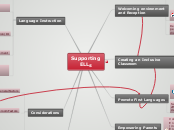Supporting
ELLs
Welcoming environment
and Reception
Initial Assessment and Placement
Assessment portfolio
STEP : initial and ongoing assessment
purposes; oral, reading and writing continua to guide instruction.
Students and parents of linguistic and cultural backgrounds feel welcomed, valued and included
Reception team, interpretors, pair with peer buddy, bilingual student, bilingual dictionaries and use of L1 in the classroom
Creating an Inclusive Classroom
Delivering a Multicultural curriculum
value linguistic and cultural diversity
use of cultural knowledge understand perspectives and world views
Incorporating first languages
Equity and equal opportunity
Involve parents
Multilingual resources
Positive attitude towards linguistic diversity
Peer tutors and Partners
Inclusive Displays and Exploring student roots
Promote First Languages
Advantages:
Socially, acdemically, emotionally; confident learner, mental flexibility, global issues connections with families
Second Language acquisition is most effective when First language is well developed
transfer of reading skills
Empowering Parents
Volunteering at school and/or in classroom
Encourage communication between home and school (interpretor, Google Translate)
Encourage reading L1 at home and in English
Understanding Curriulum www.settlement.org/edguide The Newcomer's Guide to Elementary School in Ontario
Subtopic
Language Instruction
Learning dependent on Vocabulary knowledge
Challenge: expand vocabulary twice or 3 times rate of English speaking peers and
5 years or more catch up to English speaking peers
Environment print rich
Integrating Language and Content Instrurcion
BICS and CALPS
Cummins model for planning instruction
and assessment- Cognitive and Contextual Demands
Everyday language easier than academic language
5 to 7 years for learners to develop cognitive academic language proficiency and Conversational Fluency 1 to 2 years
Program Adaptation/DI
Accommodations and/or
Modifications
Instructional Strategies:
visuals, scaffolding, journals, graphic organizers, integrated vocabulary, guided reading, technology
Co-operative Learning Strategies
Assessment
Fair
Equitable
Portfolios
Oral
Observations
Teachers can be misled by the high
degree of oral proficiency in everyday language
Considerations
General Factors
Motivational and personality factors,
learning excepionality, prior schooling,
adjustment period
ELLs with Special
Ed. needs further testing
Few similar characteristics:
motivation , low self-esteem
Over-identified as having an LD
School and Classroom Factors
Supportive language feedback provides
opportunities for interaction
Adjustment Period for ELL and Families
4 Stages:
Arrival
Cultural Shock
Recovery and Optimism
Acculturation
AR
Collaboraton
key to sharing information
Colleagues, Staff Meetings, Bulletin Boards, Parents, Websites and School Assemblies
